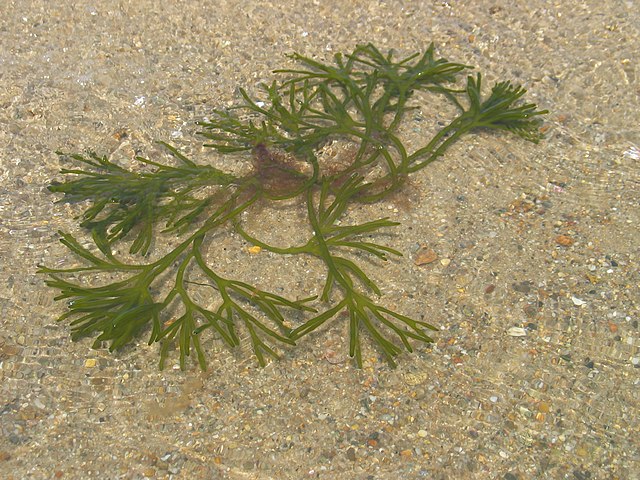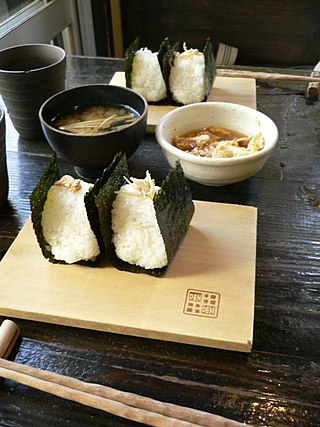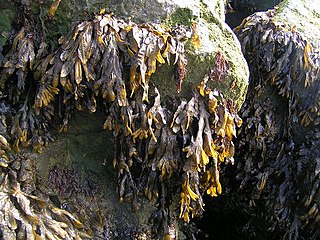Seaweed
various types of marine algae From Wikipedia, the free encyclopedia
Remove ads
Seaweed is a term used for several kinds of algae that is endemic to the ocean. Red algae, green algae and brown algae are commonly considered to be seaweed.


Seaweed gets its energy from photosynthesis, just as plants do.
Ecology
Two specific environmental requirements are important in seaweed ecology. These are the presence of seawater (or at least brackish water) and the presence of enough light for photosynthesis.
Another common requirement is a place to attach to. As a result, seaweeds are commonly found near the shore. Within that area, they are found more often on rocky shores than on sand or shingle. Seaweeds occupy a wide range of ecological niches. The highest elevation is only wetted by the tops of sea spray, the lowest is several meters deep. In some areas, seaweeds near the shore can extend several miles out to sea. The limit to how much they grow in such cases is based on how much sunlight there is. The deepest living seaweeds are the various kelps.
A number of species such as Sargassum have adapted to a fully planktonic niche and are free-floating, depending on gas-filled sacs to stay afloat.
Others have adapted to live in tidal rock pools. In this niche seaweeds must withstand rapidly changing temperature and salinity (amount of salt) and even occasional drying.[1]
Remove ads
Uses
Seaweed has different uses. Sometimes it is farmed[2] or foraged from the wild.[3]
Food

People living on the coast often eat seaweed, especially those in East Asia, such as Japan, China, Korea, Taiwan, Thailand, and Vietnam. It is also used in Belize, Peru, the Canadian Maritimes, Scandinavia, Ireland, Wales, Philippines, and Scotland.
Tiwi, Albay residents discovered a new pancit or noodles made from seaweed. These have health benefits. Seaweed is rich in calcium and magnesium and seaweed noodles can be cooked into pancit canton, pancit luglug, spaghetti or carbonara.[4]
In Asia, Zicai (紫菜) (in China), gim (in Korea) and nori (in Japan) are sheets of dried Porphyra used in soups or to wrap sushi. Chondrus crispus (commonly known as Irish moss or carrageenan moss) is another red alga used in producing various food additives, along with Kappaphycus and various gigartinoid seaweeds. Porphyra is a red alga used in Wales to make laver. Laverbread, made from oats and the laver, is a popular dish there. Affectionately called "Dulce" in northern Belize, seaweeds are mixed with milk, nutmeg, cinnamon, and vanilla to make a common beverage.
Seaweeds are also harvested or cultivated for the extraction of alginate, agar and carrageenan, gelatinous substances collectively known as hydrocolloids or phycocolloids. Hydrocolloids have attained commercial significance as food additives.[5] The food industry exploits their gelling, water-retention, emulsifying and other physical properties. Agar is used in foods such as confectionery, meat and poultry products, desserts and beverages and moulded foods. Carrageenan is used in salad dressings and sauces, dietetic foods, and as a preservative in meat and fish products, dairy items and baked goods.
Medicine

Seaweed is a source of iodine,[6] necessary for thyroid function and to prevent goitre.
Seaweed extract is used in some diet pills.[7][8][9] Other seaweed pills exploit the same effect as gastric banding, expanding in the stomach to make the body feel more full.[10][11]
Other uses
Seaweed is currently under consideration as a potential source of bioethanol.[12][13] Seaweed is an ingredient in some toothpaste, cosmetics and paints.[2]
Remove ads
References
Wikiwand - on
Seamless Wikipedia browsing. On steroids.
Remove ads
